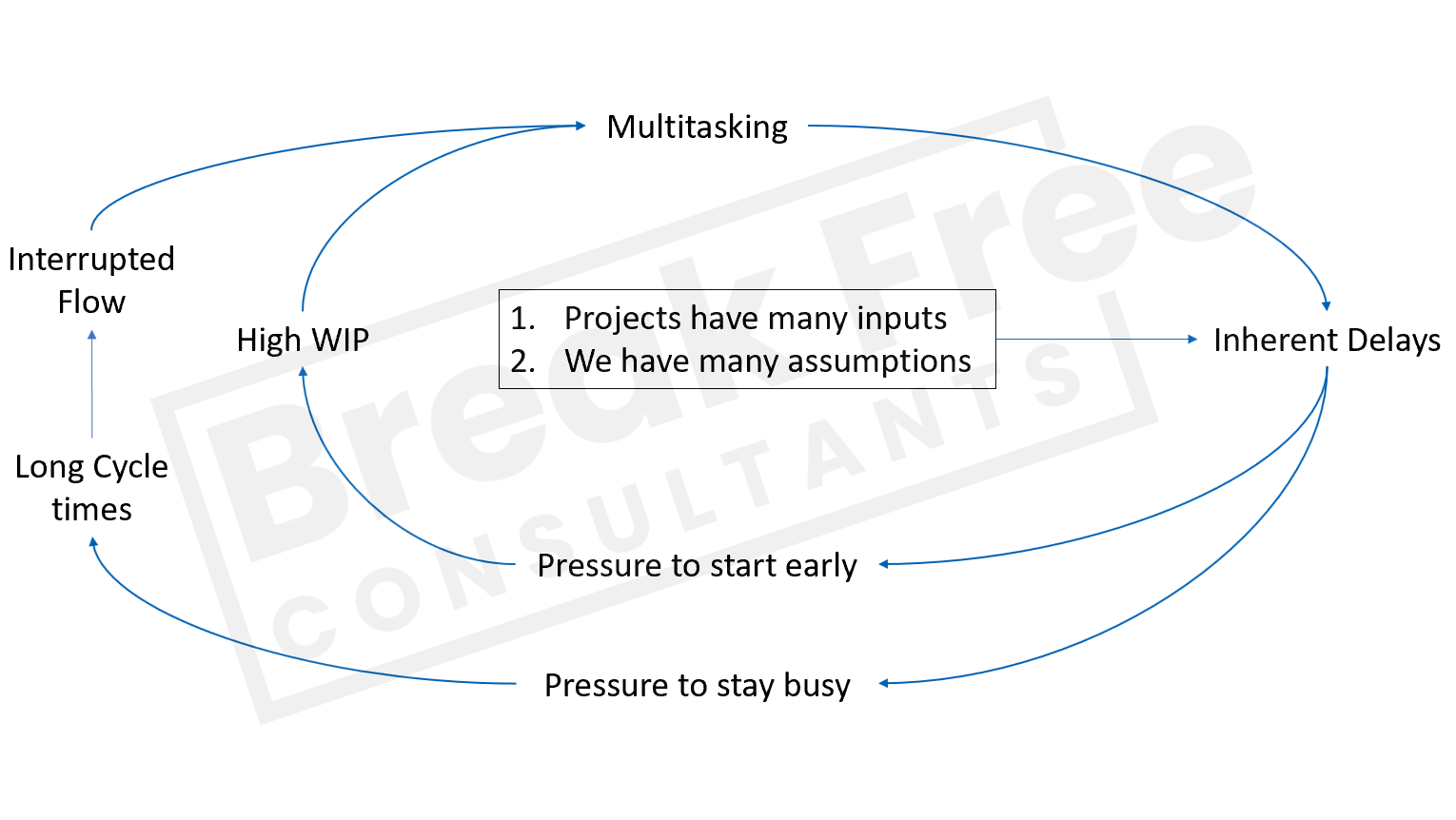In the realm of project management, inefficiencies and delays can spiral into a destructive cycle, undermining both timelines and budgets. Understanding this cycle is the first step towards Breaking Free from its grip. The Theory of Constraints (TOC) offers powerful strategies to address the root causes and transform project management practices.
The Vicious Cycle Explained
The diagram illustrates a recent vicious cycle we found working with a customer to identify their issues. Their vicious cycle is characterized by inherent delays and high work in progress (WIP). Let’s dissect the cycle step-by-step:
- Projects Have Many Inputs and Assumptions:
- Their projects are highly customized depending on the client, scope of work, and end use. Here, projects often involve multiple inputs and assumptions, leading to complexity and variability. These uncertainties can cause inherent delays.
- Inherent Delays:
- Because their projects are so complex, delays are built into the schedule to cover the inherent complexity and variability of tasks. These delays stem from dependencies, resource constraints, and unforeseen issues.
- Pressure to Stay Busy and Start Early:
- To combat their delays, there’s a management pressure to keep all team members busy and start tasks as early as possible. This often leads to initiating tasks before all necessary information or resources are available (this usually leads to a lot of frustration and re-work).
- High Work In Progress (WIP):
- Starting tasks early and keeping multiple tasks in progress simultaneously results in high WIP. Their scattered focus and multitasking disrupted workflow and efficiency.
- Interrupted Flow and Long Cycle Times:
- High WIP leads to interrupted flow, causing long cycle times. Tasks take longer to complete due to frequent switching and divided attention.
- Feedback Loop:
- Long cycle times further contribute to high WIP, creating a vicious cycle feedback loop that perpetuates inefficiencies. Multitasking exacerbates inherent delays, reinforcing the cycle.
So how did we Break Free from the Vicious Cycle with TOC?
By implementing Goldratt’s Rules of Flow! We adopted several key strategies to enhance project efficiency and effectiveness. First, we focused on high-priority tasks and allocate resources to activities that directly impacted the constraint. Next we minimized multi-tasking to reduce the number of tasks in progress, thereby improving focus and efficiency and minimizing delays caused by context switching. Then we setup tools to control Work In Progress (WIP) to maintain a smooth flow of tasks and prevent bottlenecks. Lastly, we create time buffers to absorb variability and protect the schedule from unforeseen delays, safeguarding the project’s timeline and overall success. By applying these rules, you can significantly improve your projects and achieve consistent, timely outcomes.
Goldratt’s Rules of Flow:
- Work on What Matters Most: Focus on high-priority tasks and ensure that resources are allocated to activities that directly impact the constraint.
- Minimize Multi-Tasking: Reduce the number of tasks in progress to improve focus and efficiency. This helps to minimize delays caused by context switching.
- Control WIP: Limit the amount of work in progress to maintain a smooth flow of tasks and prevent bottlenecks.
- Synchronize the Flow: Ensure that all steps in the process are synchronized to avoid disruptions and maintain a steady flow of work.
- Create Time Buffers: Establish buffers to absorb variability and protect the schedule from unforeseen delays.
Conclusion
Breaking Free from the vicious cycle of project delays requires a strategic approach that addresses the root causes of inefficiencies. By leveraging the principles of the Theory of Constraints, project managers can identify and optimize constraints, streamline workflows, and achieve timely project completion. The key takeaway is that TOC provides a powerful framework to transform project management practices and drive sustainable success.
If your projects are plagued by delays and inefficiencies, consider adopting TOC to turn things around and build a high-performing system. By focusing on the critical constraints and continuously improving processes, you can Break Free from the vicious cycle and achieve remarkable results.







